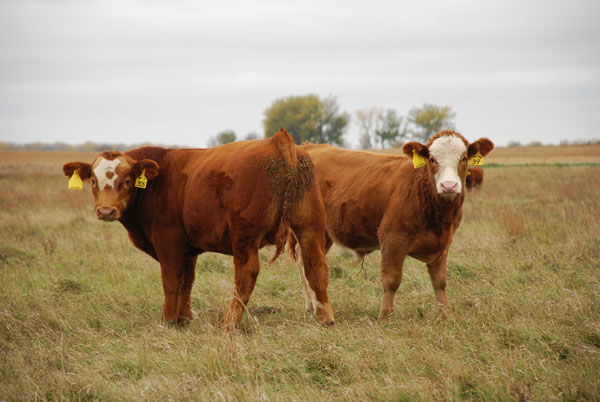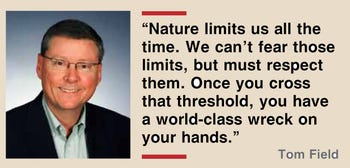Per-animal production may be approaching the limits of beef cattle’s ability, while straining the outer limits of the industry’s economic model.
January 27, 2014

"We have celebrated per-animal production as if it is the Holy Grail of livestock production,” says Tom Field, director of the Engler Agribusiness Entrepreneurship Program at the University of Nebraska. “It serves as the basis for our sustainability message, our pride in being productive and the pride we take in feeding people.”
Increased production per animal unit has been the basis of economic survival, too. Since commodity prices hover around the cost of production, by and large, the only way to increase financial return is to increase production relative to the same or similar cost.
That means that economic sustainability hinges on the ability to increase per-animal production continually.
Consider an August 2012 report from the Council for Agricultural Science and Technology that examined agricultural production relative to land and water use. The report points out that beef production (kg/hectare) increased 72% from 1961 to 2003, while chicken and pork production increased 198% and 143%, respectively. Milk production increased 126%.
“Dairy producers changed management substantially,” Field says. “A dairy today looks nothing like a dairy in 1961. Today, dairy cows receive total mixed rations. They are milked on rotary parlors, 24/7. There have been dramatic improvements in sanitation and waste management. We have made dairy cows substantially more productive.”
As dairy production increased, though, reproductive performance and longevity decreased.
“What would happen if a dairy cow had the inputs and the ability to express her full genetic potential for milk production?” Field wonders. “Could her udder even stand up? At what point in time does the system collapse?”
 In other words, there are biological and physiological limits that extend across species.
In other words, there are biological and physiological limits that extend across species.
Consider racehorses and the Kentucky Derby.
Winning Derby times between 1920 and 1969 ranged from 2:00 minutes to 2:09. Winning times since 1970 have ranged between 1:59 (Secretariat in 1973) and 2:03. Of course, Secretariat was a once-in-a-lifetime horse, at least. One tangible difference he possessed was an extraordinarily wide stride angle that made for a rare stride length.
Cracks beginning to show
Beef cattle’s biological and physiological systems are beginning to show strain. There are the visible hints, such as ambulatory problems in late-day and finished cattle.
In pastures and feedyards, Field sees more foot and leg problems, and abnormalities like scissor claw that he had never seen before. He adds that similar issues occur in the swine and poultry industries.
There’s also the less obvious reality of stagnant phenotypic production despite increased genetic potential and management opportunity.
“People don’t want to hear it, but I can find no credible evidence suggesting the average weaning weight per calf has increased in this country for the last 10 years,” said Stan Bevers, a Texas AgriLife Extension agricultural economist. That was in the January 2012's “U.S. Beef Cow Productivity Is Stagnant.”
Bevers ran Southwest SPA (Standardized Performance Analysis) numbers to get averages for the periods of 1991-1999 and 2005-2009. From the first period of time to the latter one, average weaning weight declined 36 lbs., average calving rate declined 1.3%, and average pounds weaned per cow exposed — a product of the other two measures — declined 25 lbs.
“What I worry about is that we haven’t made dramatic improvements in reproduction in any species without increasing inputs,” Field says. “Our production has required us to put more into the system. That works as long as inputs are cheap, but what happens when interest rates increase to 10%-15%?”
Subscribe now to Cow-Calf Weekly to get the latest industry research and information in your inbox every Friday!
What happens when corn prices increase from an historic average of $2-$2.50/bu. to more than $7/bu.?
The answer discovered in recent years is that increased production couldn’t overcome the increase in production costs. Even without considering biological or physiological constraints, continuous increases in per-animal production, in the name of sustainability, proved to be economically unsustainable.
At some point, the inherent system prevents additional input from yielding enough extra output to make the additional input worthwhile.
“From a pure profit perspective, at what point in time does one more pound of production not return value?” Field wonders.
Assessing the gains
“At some point, we also have to ask what the limits are relative to why we are in business,” Field emphasizes. “At our family’s ranch, and I’m not asking anyone to adopt our ethic, we’re not totally focused on short-term profit. It’s extremely important, but there are limits to what we will do to make a profit. These are limits based on our Christian values that focus on our responsibility as good stewards, and limits based on our willingness to tolerate increased inputs.”
Ironically, the industry’s penchant for balanced, multi-trait selection for traits of economic importance has steered the industry successfully toward its singular goal of increased production per animal, a collective single-trait approach.
“In business, one of the key management responsibilities is managing polarities: the decisions that are short-term in nature and the choices that are long-term,” Field explains. “If I focus on a single trait long enough, it will have consequences. What are the system limits? What are the short-term gains, and will they yield long-term benefit? As an industry, I think we need to pick up our heads and look.”
Field’s perspective is not a declaration that the cattle business’s path thus far is necessarily good or bad.
“I’m saying we need to idle for a second, apply our full senses to look, listen and smell, and then apply those observations to what we know as stockmen. We need to ask how we’re doing. Is there anything we need to do more of or less of?” Field says.
For his money, Field believes the industry’s most recent National Beef Quality Audit (NBQA) suggests the same kind of thoughtful consideration.
When it comes to any management decision, he believes the clear NBQA messages are: “Will it alter eating satisfaction? Will it negatively or positively affect the integrity of the product? Am I proud that this will be part of the industry story? Those are pretty good filters.”
Between expansion decisions on one side of the equation and growing consumer interest in how food is produced on the other, the time seems especially ripe for such industry contemplation.
“Nature limits us all the time,” Field says. “We can’t fear those limits, but must respect them. Once you cross that threshold, you have a world-class wreck on your hands.”
You might also like:
10 New Farm Trucks To Consider For 2014
25 Things To Put On Your Calving Check List
BEEF Readers Say Plan To Expand In 2014
About the Author(s)
You May Also Like





